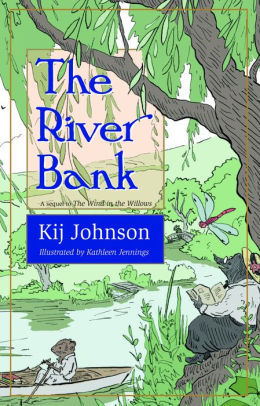A sequel and response to Kenneth Grahame’s 1908 children’s book The Wind in the Willows, Kij Johnson’s The River Bank returns to the titular neighborhood of charming animals and their troubles. The bachelors of the River Bank—Mole, Rat, Badger, and Toad—are thrown into confusion when two young female animals, Beryl the Mole and a Rabbit, rent a cottage up the lane and join their community. There are misunderstandings, adventures, kidnappings and ransoms; The River Bank is a jaunty story.
Johnson, best known for her award-winning short fiction directed toward an adult audience, has gone for something rather different than her usual with this novel. When I saw the title announced, several months prior to this, I was not expecting it to be a follow-up to a world famous children’s book—especially given that the last piece I read by Johnson was The Dream-Quest of Vellitt Boe (reviewed here), a mature and thoughtful novella using cosmic horror tropes to intriguing effect.
Really, though, The River Bank is almost cousin to The Dream-Quest of Vellitt Boe in approach and intention. I would describe them both as stories for writers: both stand on their own narratively, but a not insignificant portion of their charm comes from their thorough intertextuality. That makes the intended audience for The River Bank an intriguing question I sat with for awhile after finishing the book—it is, definitely, in the same prose style as the original text and would be accessible to a young readership. So, it’s still a children’s book.
However, it’s also a love’s labor from a grown adult to other grown adults who have the same childhood fondness for Grahame’s novel and would appreciate seeing its gender politics and social assumptions challenged. The return to the text is the romantic gesture; the revision of the text is the bit that hooks me. Johnson manages to balance them in such a way as to avoid creating a preachy “update” to the original that doesn’t have a life of its own, which made for a satisfying reading experience.
After all, it’s a project worth doing. The original novel is a product of its time. Johnson wouldn’t be able to approach a sequel without addressing the cultural shifts produced over the last century—but she also was careful to come to the table with a story first rather than a mission, and that sense of balanced love and criticism makes for a thoroughly engaging result. I haven’t actually read The Wind in the Willows since I was a kid myself, but I can say that Johnson’s tone and approach put me right back to that mindset, except with the addition of social commentary and self-awareness that hooked me at this moment as an adult.
The lack of romance is also a solid choice. I appreciated that Beryl and Rabbit both find it silly to the point of hilarity that the bachelors at the end of the text believe they must be married off, having been unsupervised in male company overnight. Rabbit kindly rejecting the Toad’s offer of marriage, despite their companionship and adventure together, is a perfect touch. As she notes, she has no intention of weighing herself down with a marriage at this point in her youth. I got a good smile from that whole scene. Johnson has there written an exchange that a young feminist might have written in 1908 in a similar book: aware of the changing times and expectations, faintly amused at the cluster of men who never interact with women usually but believe they know best straight away.
There are also asides to issues of class and labor that are avoided in the original, given the animals’ sedentary, wealthy lifestyle. Johnson notes the suburbs and poor neighborhoods, having Rabbit observe in Town that she doesn’t know how people can live like that—dreary, close, and without greenery. When Toad says they must do so because they like it, she observes that they’re probably forced by “this work one is always hearing about. It must be a thing one may only do in the Town.” It doesn’t belabor the point, which makes it all the more effective at maintaining the tone of the original novel but updating it as well.
Overall, The River Bank was a soft and pleasant diversion of a book. The prose is delightful, matching Grahame’s as it does but with Johnson’s own unique sense of humor and scenery—and, given that Beryl is herself a writer, it often has a clever self-referential quality that I found charming. The illustrations scattered throughout also add to the sense of place and time Johnson has constructed with this return/revision. It’s a different kind of project than I expected but I can’t say I’m at all disappointed. I wouldn’t have thought I needed a sequel to The Wind in the Willows, but Johnson has done a fine job here by making me realize I wanted one and delivering it all at the same time.
The River Bank is available from Small Beer Press.
Lee Mandelo is a writer, critic, and editor whose primary fields of interest are speculative fiction and queer literature, especially when the two coincide. They have two books out, Beyond Binary: Genderqueer and Sexually Fluid Speculative Fiction and We Wuz Pushed: On Joanna Russ and Radical Truth-telling, and in the past have edited for publications like Strange Horizons Magazine. Other work has been featured in magazines such as Stone Telling, Clarkesworld, Apex, and Ideomancer.










